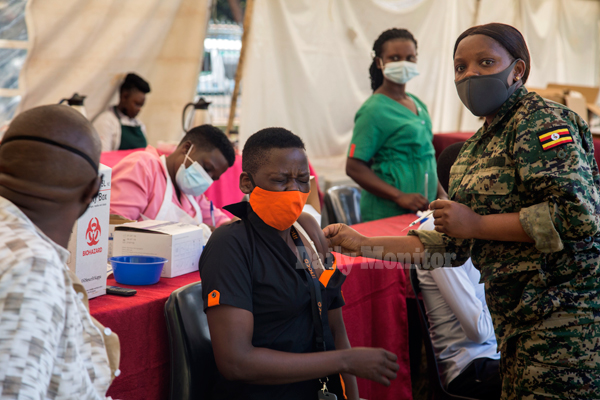How Covid jabs are made

An army health official administers the Pfizer vaccine during a mass vaccination exercise at City square in Kampala last Thursday. PHOTO | ISAAC KASAMANI
What you need to know:
- Vaccination. By Saturday, more than 6.6 billion doses had been administered world over, with 36 percent (2.84 billion) of the world population fully vaccinated.
Health experts have urged Ugandans not to treat available Covid-19 vaccines with scepticism.
Uganda has a wide range of vaccines including AstraZeneca, Pfizer, Sinovac, Johnson & Johnson, and Moderna.
By Saturday, 2,575,021 doses had been administered with the uptake described as being mixed.
Scientists in the country have consequently assured the public about the safety and efficacy of the available vaccines.
Dr Catherine Kyobutungi, a resource person at the Nairobi-based African Population and Health Research Centre (APHRC), said the technology used to develop Covid-19 vaccines falls into three broad categories.
She added that the difference in the three approaches lies in whether scientists use part of or the whole virus/bacterium that triggers the immune system.
The first approach involves using a genetic material that provides the instructions for making specific proteins and not the whole virus.
They include the whole-microbe approach where scientists develop the inactivated vaccine, the live attenuated vaccine and viral vector vaccine
The whole-microbe approach is where a disease carrying virus is inactivated using chemicals through heat or radiation. Vaccines for polio and flu are made using this method where two or three doses have to be administered.
The live-attenuated vaccine is where scientists use a living — if weakened — version of the virus to develop the vaccine. Measles, mumps and rubella (MMR) vaccine and chickenpox are examples of this type of vaccine.
This approach uses similar technology to the inactivated vaccine and can be manufactured at scale. Its vaccines may, however, not be suitable for people with compromised immune systems.
The third vaccine type under this technology is viral vector vaccine where scientists use a safe virus to deliver specific sub-parts — or proteins of the germ of interest — to trigger an immune response without causing disease.
To do this, instructions for making particular parts of the pathogen of interest are inserted into a safe virus. The safe virus then serves as a platform or vector to deliver the protein into the body where the protein triggers the immune response. This type, which can be developed rapidly, includes the Ebola vaccine.
The second technology used is the A subunit approach and this is where scientists use specific parts of a virus or bacterium that the immune system needs to recognise. It doesn’t contain the whole microbe or use a safe virus as a vector.
The subunits may be proteins or sugars. Most of the vaccines on the childhood schedule are subunit vaccines, protecting people from diseases such as whooping cough, tetanus, diphtheria and meningococcal meningitis.
The last approach is the genetic approach where nucleic acid vaccines are developed.
Dr Kyobutungi said unlike vaccine approaches that use either a weakened or dead whole microbe or parts of one, a nucleic acid vaccine just uses a section of genetic material that provides the instructions for specific proteins, not the whole microbe.
“DNA and RNA are the instructions our cells use to make proteins. In our cells, DNA is first turned into messenger RNA, which is then used as the blueprint to make specific proteins. A nucleic acid vaccine delivers a specific set of instructions to our cells, either as DNA or mRNA, for them to make the specific protein that we want our immune system to recognise and respond to,” she said.
mRNA technology
The mRNA technology is a new way of developing vaccines. Before the Covid-19 pandemic, none had yet been through the full approval process for use in humans. A few such vaccines targeted at particular cancers were undergoing human trials.
Research in mRNA technology, however, progressed very fast during the pandemic so much so that vaccines have received authorisation from the World Health Organisation (WHO) for emergency use. WHO has approved 21 vaccines thus far.
The mRNA Covid-19 vaccines available in Uganda include Johnson & Johnson, Pfizer, and Moderna. Dr Kobutungi says the vaccines approved for emergency use create immunity within the body system not to cause severe effects once someone is infected with the virus.




